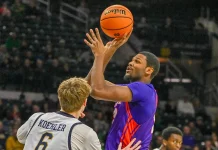BLOOMINGTON, Ind. – Seven former Indiana swimming and diving student-athletes, six men and one woman, were named to the College Swimming Coaches Association of America’s lists of 100 Greatest Swimmers and Divers of the Past 100 Years.
Indiana was one of six collegiate programs to with six athletes selected to the men’s list. All six, four swimmers and two divers, were part of IU’s dynasty in the 1960’s and 1970’s that saw the Hoosiers capture six straight national championships from 1968-73.
Lilly King (2016-19)
The first woman to win eight NCAA breaststroke titles, Lilly King dominated during her collegiate career at Indiana University, setting records in the 100-Yard Breaststroke (55.73) and, at the time, the 200-Yard Breaststroke (2:02.60). Over four seasons, King won nine Big Ten Championships and earned All-America accolades in eight breaststroke events and eight relay events.
King is a four-time Olympic medalist between and traveled to both the 2016 and 2020 games. In 2016, King won gold in both the 100-Meter Breaststroke and 400-Meter Medley Relay. This summer at the 2020 Tokyo Games, King earned bronze in the 100 Breast and silver in the 200 Breast and 400 Medley Relay.
Ken Sitzberger (1965-67)
Ken Sitzberger helped lay the foundation for diving success at Indiana University. The first IU NCAA Champion on the 3-Meter Springboard, Sitzberger won again in 1967. Sitzberger was also a national champion in the 1-Meter all three years in Bloomington, helping the Hoosiers to two runner-up placements and one third-place team finish.
Sitzberger earned a gold medal in Springboard Diving at the 1964 Tokyo Olympics a year before beginning his collegiate career in Bloomington.
 Charlie Hickcox (1967-69)
A member of Indiana’s first two national championship squads in 1968 and 1969, Hickcox featured most prominently in the backstroke events in which he won five NCAA titles. Hickcox also won the 100 Individual Medley twice and took part in Indiana’s 1969 national champion 4×100 medley relay team.
Hickcox won four medals at the 1968 Olympic Games in Mexico City, taking gold in three of those events – the 200 and 400 Individual Medley events and the 400 Medley Relay. He also earned silver in the 100 Backstroke.
 Jim Henry (1968-70)
Featuring in the first three of Indiana’s six straight national titles from 1968-73, Henry followed the success of Ken Sitzberger for Indiana diving. In his first season, Henry took the 1968 national title in the 1-Meter Springboard, then followed the next two seasons with sweeps of the 1M and 3-Meter titles.
Henry competed in the 1968 Olympic Games in Mexico City where he took bronze in Springboard Diving.
 Mark Spitz (1969-72)
Mark Spitz called choosing Indiana “the biggest decision of my life (and) the best.†It was certainly successful. During his time in Bloomington, Spitz won eight individual NCAA titles, 14 medals, four team titles and, in 1971, the James E. Sullivan Award as the nation’s top amateur athlete.
Spitz totaled 11 medals between the 1968 and 1972 Olympics, and nine of those medals were golds. At the 1972 games in Munich, Spitz won gold in all seven events he competed in and broke world records in each.
 Gary Hall (1970-73)
Gary Hall was part of the final four seasons of Indiana’s run of six straight national championships from 1968-1973, contributing 13 total medals and eight NCAA titles. Hall especially excelled in the individual medley at IU, winning five medals between the 200 and 400-yard events.
Hall competed at three Olympiads from 1968-1976, totaling three medals in three different events.
 John Kinsella (1971-74)
Taking part in three Indiana national championships from 1971-73, John Kinsella won the individual title in the 500-Yard Freestyle and 1650-Yard Freestyle all three of those seasons. In his final year in cream and crimson, Kinsella helped IU win the 800 Free Relay in 1984.
Kinsella competed at the 1968 and 1972 Olympics, winning a medal in each. At the Mexico City games, Kinsella took home silver in the 1,500-Meter Freestyle and then earned gold in the 800 Free in Munich four years later.




